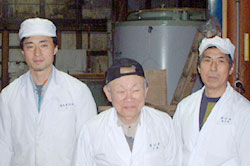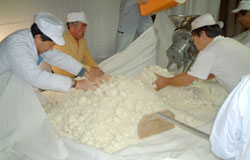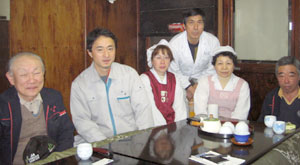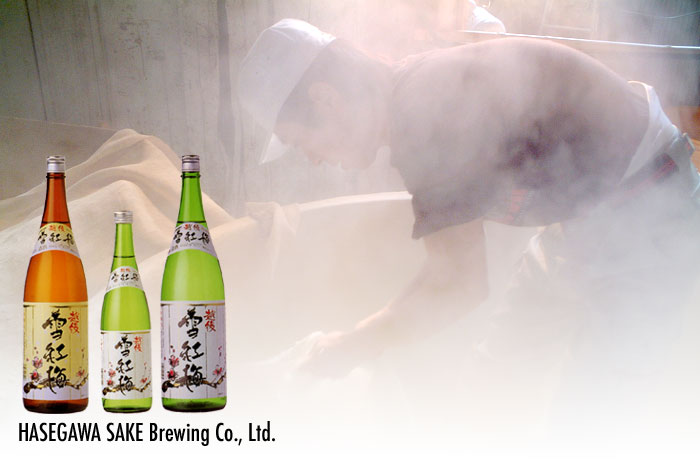 |
|||
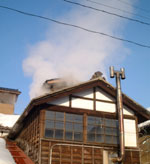 8 o’clock AM. 0 deg C (32 deg F). Mornings are early at a sake brewery. From the roof of the brewery still loaded with snow, clouds of steam rise into the cold open air. The contrast of the calm morning sun and white steam implies that brewers had been steaming a large quantity of brewer’s rice with a koshiki (a tool used to steam rice) inside. This scenery at the brewery hasn’t changed a bit over time, which is proof that tradition is preserved in sake brewing. 8 o’clock AM. 0 deg C (32 deg F). Mornings are early at a sake brewery. From the roof of the brewery still loaded with snow, clouds of steam rise into the cold open air. The contrast of the calm morning sun and white steam implies that brewers had been steaming a large quantity of brewer’s rice with a koshiki (a tool used to steam rice) inside. This scenery at the brewery hasn’t changed a bit over time, which is proof that tradition is preserved in sake brewing.
HASEGAWA SAKE Brewing Co., Ltd., whom we interviewed, is located in Nagaoka city, Niigata pref. and is a time-honored sake brewery which was established in the Edo period (1603-1867). In October, 2004, the Niigata Chuetsu Earthquake destroyed half of the brewery, but still they continue to make Japanese sake “by hand”. We had the opportunity to talk with Mr. Akiro Hasegawa, Director and Sales Manager of HASEGAWA SAKE Brewing and Mr. Tadashi Yoshihara (73-years-old), the toji. The toji commands all of the brewers working at the brewery and is responsible for all aspects of sake brewing. The toji is the master of the brewery and a sake brewing specialist. (Interviewed on Feb 20, 2006) |
|||
| We INPC believe that Niigata’s specialty, Nishikigoi, and Japanese Sake are similar in that they are traditional products made by Niigata’s nature and artisans’ skills. Are there things Japanese sake brewing enjoys of Niigata’s nature, especially the climate? | |||
|
Mr. Yoshiwara
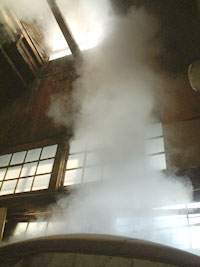 Of course there are. To make sake, ingredients such as rice and water are important, but more than that, the area’s climate. Niigata’s winter brings a lot of snow and that is just the right environment for sake brewing. In warm climate regions, the brewery needs to be big because it needs to be equipped with a machine to cool the room. But Niigata’s cold weather is great for a small brewery like us with natural brewing methods. Mr. Hasegawa
Mr. Hasegawa |
|||
| Does Niigata have any unique “natural blessings”, not to mention the winter climate? | |||
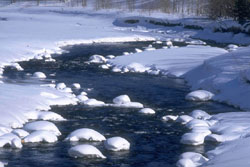 Mr. Hasegawa Mr. HasegawaNiigata has great water. We use river-bed water of Shinano River, Japan’s longest river, for shikomi. Since the water is soft with less minerals, almost like distilled water, it makes the sake mild and round. Japanese sake is made approximately 80% of water, so the quality of water directly affects the flavor of sake unlike other fermented liquors such as wine. That it to say, Niigata’s water is very valuable. Mr. Yoshiwara |
|||
| Like Nishikigoi production which has a history of 200 years, HASEGAWA SAKE Brewing has a tradition of more than 100 years, too. Are there difficulties in keeping the tradition or changing it? | |||
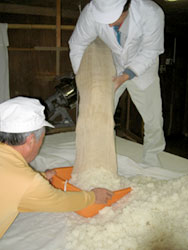
Mr. Yoshiwara The process of sake brewing is basically the same as it was in the Edo period. All we have done is mechanize what humans used to do by instinct. But even so, there are always things that need to be done by hand. For example, in the process of koji making, a machine (a hose) is used to cool the rice. But this process is done better by hand because the rice is less affected when slight adjustments in the temperature can be made. By cooling the rice carefully by hand, we can tell “which spots are too cold” or “when a rice grain is broken”. A machine can’t recognize those errors. Tradition is nothing special. It is only to be able to distinguish such errors using our experience and to make good sake Mr. Hasegawa I believe changes are needed in sake brewing, but that doesn’t necessarily mean to buy the most up-to-date machinery. Our renovation is to dig ourselves into sake brewing by repeating “refinement” using only the essential machinery to be in line with the times. |
|||
| At last, what are the characteristics of HASEGAWA SAKE Brewing’s “Sekkobai”? | |||
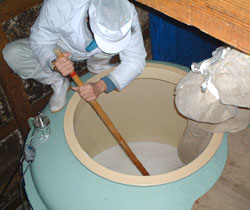 Mr. Hasegawa Mr. HasegawaWe make “Sekkobai” by imaging the snowbreak in spring. As its name suggests, it is handmade sake with pronounced flavor unique to our brewery. Dry and pure sake is popular nowadays, but I have no intention of changing the way we do things just because something becomes popular. We are a small brewery with only 3 brewers, so we can’t make tons of sake nor can we purchase the latest machinery. But instead, we want to keep the tradition of rich “handmade” flavorful sake. We believe it is important to dig in and to brew sake with lots of attention. Mr. Yoshiwara |
|||
| Thank you for your time today. | |||
|
|
 INPC, with cooperation of Hasegawa Sake Brewing Co., Ltd., have created an original label with images of Nishikgoi. Please enjoy the refreshing and fruity flavor of Dai-Ginjo "Sekkobai." HASEGAWA SAKE Brewing Co.,Ltd. http://www.sekkobai.ecnet.jp/ 2-7-28 Settaya, Nagaoka-shi, Niigata-ken, Japan tel:81.(0)258.32.0270/fax:81.(0)258.35.6066 |
||
